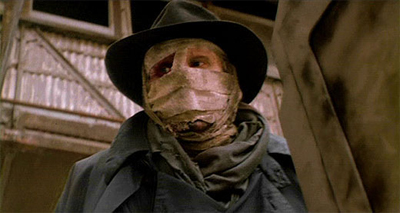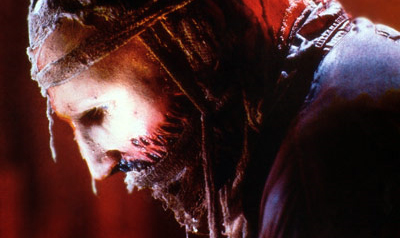This is a post as part of “Raimi-fest”, the event being organised by the always wonderful Bryce over at Things That Don’t Suck.
Spider-Man wasn’t Sam Raimi’s first foray into the world of superheroes. Darkman stands as one of the very few earnest superheroes created originally in the medium of film (as opposed to being adapted from comic books or other pulp fiction), and it’s certainly an interesting and entertaining feature. Going on to produce two direct-to-video sequels, some books, some comic books and even a computer game, the character is the very definition of “cult.”
The film is a direct result of Raimi’s attempts to secure the rights to well-known and established comic book characters – in the hopes of producing an adaptation as the director’s first major studio film. Indeed, Batman was reportedly one of the characters Raimi had wanted to work on, and you can detect a clear connection between the avenging scientist featured here and DC’s Dark Knight. Danny Elfman’s score calls to mind quite a few music cues from Tim Burton’s Batman, and there’s a very familiar shot of Darkman perched on a rooftop like an avenging crusader.
However, the far stronger influence is the original pulp hero The Shadow. The Shadow did receive a major big-screen adaptation (with Alec Baldwin), but there are obvious influences on this original superhero. The most obvious is the “master of disguise” element of the character, with the Shadow regularly adopting any number of false identities to manipulate and secure information on his adversaries. The title character here uses a similar modus operandi, using advanced technology to let him wear the faces of various people for up to 100 minutes. Beyond that, there’s the rather obvious fact that the hero dresses in a black suit with a fedora, rather than more modern and traditional superhero garb.
The movie opens with a collection of old Universal logos, celebrating the 75th birthday of the film studio. This immediately sets the tone and betrays Raimi’s influences. Darkman might, structurally and thematically, resemble a conventional superhero tale, but the director is drawing from a rich cultural mythos which extends to the pulpy material which (ever so slightly) pre-dates the classic heroes. Darkman is a ma, wounded and scarred by mobsters. His face is disfigured, and he’s left unable to control his emotions – prone to bouts of random rage. In short, he’s a monster – but not one by choice.
Raimi returns, time and time again, to the image of the sideshow freak. During one of the eponymous character’s freakouts, he does a dance and sings a song about being one of the freaks in a freakshow. Later on, as he braces himself to tell his lover the truth, he is convinced not to when he sees the treatment of the fun fair’s freak. It’s these sorts of moments which hint at the classic movies which inspire a lot of Raimi’s work – films like Freaks or like the Universal Frankenstein. In a style that would influence how he would handle Spider-Man, the movie is a clear homage to those classic “creature features.”
More than that, though, the movie seems aware of its pulp roots in a way that no film since Richard Donner’s Superman really had been. Notwithstanding the indifference that Tim Burton’s Batman showed to death, Darkman represents the first time that a big screen superhero movie accepted that it could feature a slightly damaged leading character (emotionally, as well as physically). There are times when Liam Neeson’s leading character seems to almost come off the rails about, yelling and shouting and remaining more than indifferent to large-scale casualties along the bad guys.
In a moment which wouldn’t seem out of place in Frank Miller’s grim and gritty The Dark Knight Returns, an informant pleads to Darkman that he has already revealed all the information – he’s told him everything he needs. Darkman hesitates for a moment. “I know you did,” he concedes, “but let’s pretend you didn’t.” He then sticks the poor guy’s head through a manhole cover and waits for a passing car to finish him off. Now, that is a hard-boiled anti-hero right there. It would take some time for superhero movies to embrace the idea that there leads didn’t necessarily need to be squeaky clean, but Raimi was already well ahead of the pack.
The movie also gets bonus points for being aware of a lot of genre conventions, even as the superhero movie genre had yet to really explode. In true “fake superhero death” style, we’re informed that Darkman’s remains were never really found. “All they found was an ear, tiny little piece,” the grave digger remarks. “Didn’t take me long to bury that.” Of course, nobody asks how they only found an ear, but it’s a nice little acknowledgement of a plot device so heavily used it’s almost a cliché. Similarly, the movie also offers us a montage of Darkman working on science stuff, simply because a superhero science movie needs a montage. I don’t know why, but the image of Darkman, with his bandages, wrestling with a scientific calculator cracks me up.
Of course, that sort of cheesy self-awareness isn’t for everyone. And, in fairness, the movie does go a little bit too far at times. It’s clearly meant to demonstrate the character’s psychotic breakdown, but there’s nothing especially harrowing about hearing Liam Neeson demand, “I want the pink elephant for my girlfriend!” It’s more ridiculous than tragic, and that blows away any possible hint of emotional poignancy that a scene like that really needs in order to work. Still, those moments of excess are few and far apart. However, you should be warned – Darkman is never shy about the fact that all it wants to be is silly fun. After all, there’s nothing wrong with that, right?
Liam Neeson is, as ever, solid in the leading role. It’s interesting to note his accent. The actor wasn’t yet firmly established, so his accent is very clearly American. There’s no hint of his smooth and sexy Northern Irish accent creeping in beneath that, like in Batman Begins or even Taken. He does a great job of emoting under superb make-up, a task many actors struggle with. Frances McDormand offers sturdy support as the love of his life. By the way, check out the cameos. There’s Jenny Agutter from Spooks, giving a tour to Ivan Raimi and John Landis. Bruce Campbell appears briefly. Hell, if you look closely, you can spot Joel and Ethan Coen driving the car from Evil Dead II.
Darkman isn’t a masterpiece. It’s heavy on the typical superhero clichés and it doesn’t necessarily have the budget a project like this would need. That said, the use of standard tropes helps the movie work as a pastiche of any number of comic book heroes, making the story Raimi wants to tell seem instantly recognisable. And the look of the film is interesting enough to merit attention. There are some difficulties – the movie never feels like it’s building to a climax… it just sorta happens – but the ride is entertaining enough that it’s easy just to go along.
Filed under: Non-Review Reviews | Tagged: batman, danny elfman, dark knight returns, dark man, Darkman, Evil Dead II, Ivan Raimi, liam neeson, non-review review, Raimi, review, sam raimi, spider man, tim burton |

























Nicely done Darren.
With his dark methods and looks, revenge based plots, and body count I always thought Darkan had just as much in common with The Pulp Heroes as the comic ones.
Thanks Bryce!
“The Shadow has yet to receive a major big-screen adaptation…”
http://www.imdb.com/title/tt0111143/
Corrected. Thanks.
For some reason I always associated Alec Baldwin with that awful Phantom adaptation, also from the mid-nineties.